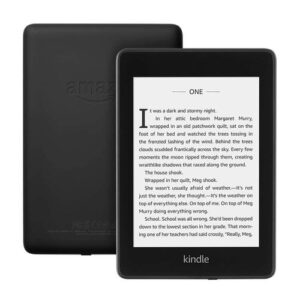Amazon admits to selling “tens of millions” of their enduringly popular Kindle devices since the e-reader changed the way we read back in 2007.
What does Kindle mean, though?
Naming of Amazon Kindle
Jeff Bezos, founder and CEO (now executive chairman) of Amazon wanted to beat competitors to the punch by launching the world’s best e-reader.
In 2004, Amazon employees were tasked with transforming the device, codenamed Fiona, into a reality.
The name Kindle was conjured up by husband and wife team Michael Cronan and Karin Hibma of Cronan branding consultants. When Lab126 – Amazon’s R&D wing – asked Cronan to name the forthcoming e-reader in 2007, Cronan wanted to create a name suggesting humility and starting something new, just like kindling a fire. The metaphor was intended to encapsulate intellectual excitement, according to Cronan.
With the name in place, it was time to unleash Kindle on the world.
First Generation of Kindle
The original iteration of Amazon Kindle was launched on November 19, 2007. Retailing at $399, the device sold out in less than 6 hours. Astonishingly, the e-reader then remained out of stock until the end of April the following year.
Kindle packed a 6-inch grayscale E Ink display. With 250MB of internal storage, the device had room for around 200 titles. Storage could be expanded via SD card. Kindle came with a speaker and a headphone jack to promote listening to audio files. Users could access Amazon content using Sprint’s 3G data network. Whispernet, a dedicated protocol, was created for the purpose.
The original Amazon Kindle was not sold outside of the U.S.
Second Generation of Kindle
Amazon announced the launch of Kindle 2 on February 10, 2009. The device came to market on February 23.
Memory was ramped up to 2GB internally. Unlike original Kindle, though, there was no capacity for SD card storage.
A text-to-speech option allowed for text to be read aloud.
Kindle 2 was physically slimmer than the first iteration
As a promotional effort, Stephen King released his new novella, Ur, exclusively through Kindle Store.
Later that year, Amazon announced an international version of Kindle 2. This came with the ability to download books wirelessly. Launched on October 19, 2009, this international Kindle 2 was released in more than 100 countries worldwide. This model was the same as the standard Kindle 2, except for using alternative mobile network standards. Where Kindle 2 used the Sprint network, the international device used either GSM or 3G GSM.
In the decade since these early days of Kindle, the original device has gone through ten generations, and Amazon bolstered the range with many other e-readers, as well as a range of Fire tablets.
How does the line of Kindles shape up in 2021, then?
Kindle 2021 Range
There are currently 4 different models of Kindle:
- Kindle
- Kindle Kids’ Edition
- Kindle Paperwhite
- Kindle Oasis
Kindle
The most recent iteration of Amazon Kindle – the tenth generation – was announced by Amazon on March 20, 2019.
Kindle 10 is the first base model featuring a front light. This consists of 5 LEDs rather than the stack of 5 used on Paperwhite – see below.
The 6-inch display has a higher contrast than you find on the outgoing iterations of basic Kindle. Resolution remains 167ppi.
This entry-level model still has a black and white display in 2021.
Kindle Kids’ Edition
The Kindle Kids’ Edition is a tenth-generation Kindle with a protective cover, a worry-free, 2-year guarantee, and a year’s subscription to Amazon Kids+.
Give your children access to over a thousand age-appropriate titles, and rest easy knowing they won’t drop and smash the device.
Kindle Paperwhite
Today’s Kindle Paperwhite is the fourth-generation model launched back in November 2018. This is commonly called Paperwhite 4.
This model has a 6-inch, 300ppi display. The screen has 5 LED lights.
IPX8 waterproofing allows Paperwhite 4 to be fully submerged in up to 6 feet of fresh water for an hour. It will certainly stand up to a few splashes from the pool, or even being dropped in the bath.
There are 3 distinct versions of this model:
- 8GB WiFi
- 32GB WiFi
- 32GB WiFi and LTE
You can play audiobooks on Paperwhite 4 only by using headphones or an external Bluetooth speaker.
Paperwhite 4 has been consistently well-reviewed, with praise lavished on the crisp display, impressive water resistance, and outstanding battery life. The absence of physical buttons and USB-C are the minor drawbacks of this otherwise exceptional e-reader.

Kindle Oasis
Oasis 3, the third generation of this device, was launched in mid-2019.
This iteration looks almost the same as the outgoing model. The 7-inch screen has the same 300ppi E Ink display.
You can adjust the warm light and use this device one-handed. It also features an upscale aluminum exterior and waterproofing.
The 25 LED front light allows you to manipulate temperature warmth. This is the first Kindle boasting that ability.
OK, if you came here today with no idea what Kindle means, that should have changed. You should also be clear about the current line of Kindle devices.
Before we close today, how about Kindle Voyage?

Whatever Happened to Kindle Voyage?
The Verge raved about Kindle Voyage called it “the best E Ink e-reader” and “unquestionably the best Amazon has made.”
Launched in late 2014, Kindle Voyage boasted a 6-inch, 300ppi E Ink HD display. At the time, this represented the pinnacle of contrast and resolution for e-readers.
6 LEDs automatically illuminated the screen of this model according to the environment.
What was the problem, then?
Well, despite costing significantly more than Paperwhite, Voyage offered no substantial benefits in return. The rest, as they say, is history.
Final Thoughts
We hope you’ve enjoyed today’s dissection of the naming of Amazon Kindle.
We have a busy content calendar over the coming month at Pick My Reader, so be sure to pop back soon for more entertainment and all the best e-readers. See you soon!


